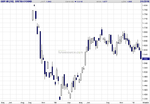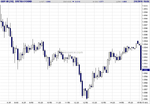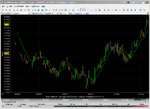huge return, but no total loss control yet
Here it is. Long and short trades. One loss got out of control, because I let it slip away, but I got lucky and from 40% it got to 5%. I still need to practice loss control, because I must really never let a loss get bigger than 10%. I did however manage to take breaks between trades and longer breaks between stocks, and that lack of trading frenzy and breathlessness is what enabled me to get to the end with a good balanced mind and such huge returns, which actually improved over time, because I learned to let profits run a little more.
Other than this, the return is huge: with 101 trades I made over 1000%, bringing capital from 10k to 120k. This cannot be randomness. This alone disproves the random walk theory.
 Learning to control losses is my main objective
Learning to control losses is my main objective
My aim for the future, is to repeat such 100-trades feats, end them all profitably, finish them within a few hours like I did with this one, get faster and faster at playing them but at the same time stay fully in control of losses by keeping myself detached emotionally, which, as practice increases, should require shorter breaks.
I finally found something related to trading where obsessiveness pays off
I am very satisfied. I finally found something in trading where my obsessiveness can be put to work and produce good results. Until now it was just obsessiveness at blowing out accounts. They say that practice makes perfect but until this game i never really found this to be true for trading. The more I traded the more I lost. However, with automated systems, i found my first field where my work produced results. Now, with this chart game, I found a second field. Maybe over time even with discretionary trading I got more accurate, but until I'll solve my stoploss problem all the accuracy in the world won't do me any good, since when I incur a loss until now I've always let it run forever.
My first profitable discretionary trading ever
This is turning out to be my first profitable discretionary trading. It's not exactly like real trading because time doesn't go by this fast and at your click, but it's close enough. Once I'll ace this chart game and particularly once I'll develop complete confidence that I can be profitable and learn to control my losses, then it'll be like for all those things you know that can be done, like juggling, riding a bicycle... once you can do it, no matter how much time goes by, you'll always be able to do it.
When you find out you can make money, you understand you can take losses
I believe the step number one, which already happened, was to really realize that I can make money by reading the charts, and I would say that this is pretty clear by now. The step number two, still in progress, is to learn to let your losers go. Since you are good at winning, you don't have to win each and every time, and should be able to accept that once every 3 times you will lose. Yeah, because this seems to be the case so far: i lose once every three times, and my losses are about one third of my wins (average of 7% vs 21%). So it goes like this, on average: plus three, plus three, minus one... and then all over again. If I keep my pace, and space trades apart, and keep these results, it should become natural to prefer taking one small loss and two bigger wins, rather than trying to have no losses at all and most definitely incur, within 100 trades, into at least one disastrous loss.
100 trades forces me to face losses, whereas just 20 trades did not
Yeah, this is why it was so important that i set my number of trades to 100. If you're not doing things right with just 20 trades, you could still get lucky, and if something goes wrong, you could still restart all over again. But 100 trades take you hours to be done properly, and you will definitely not get lucky. And if you're doing something wrong, it will show during those 100 trades. If you just hope to get lucky and get away with not using a proper stoploss, you'll end up starting over and over again for days before you can find a series of trades where your losses come back to your entry so that you get 100 profitable trades.
Here are all my trades, from biggest loss to biggest win:
-14.53%
-11.80%
-9.85%
-8.98%
-7.15%
-6.27%
-4.37%
-2.05%
-1.50%
-0.84%
0.00% (FLAT)
0.00% (FLAT)
1.03%
2.96%
6.22%
6.48%
6.64%
9.50%
12.42%
14.57%
14.73%
14.74%
21.24%
21.64%
23.74%
25.58%
31.17%
41.27%
43.22%
71.64%
Actually they're not always just one trade, because the trades are not listed by the chart game but just the stocks. But they're close enough to the proportion of trades, even though these are actually the
groups of trades made on each stock.
I guess I'll be doing this 100-trades series no more than once a day, but always all within one day, and several times a week. I'll do it until i achieve full confidence in my profitability and full control of losses. I must never be even slightly tempted to let a loss run. And never make any careless trades.





